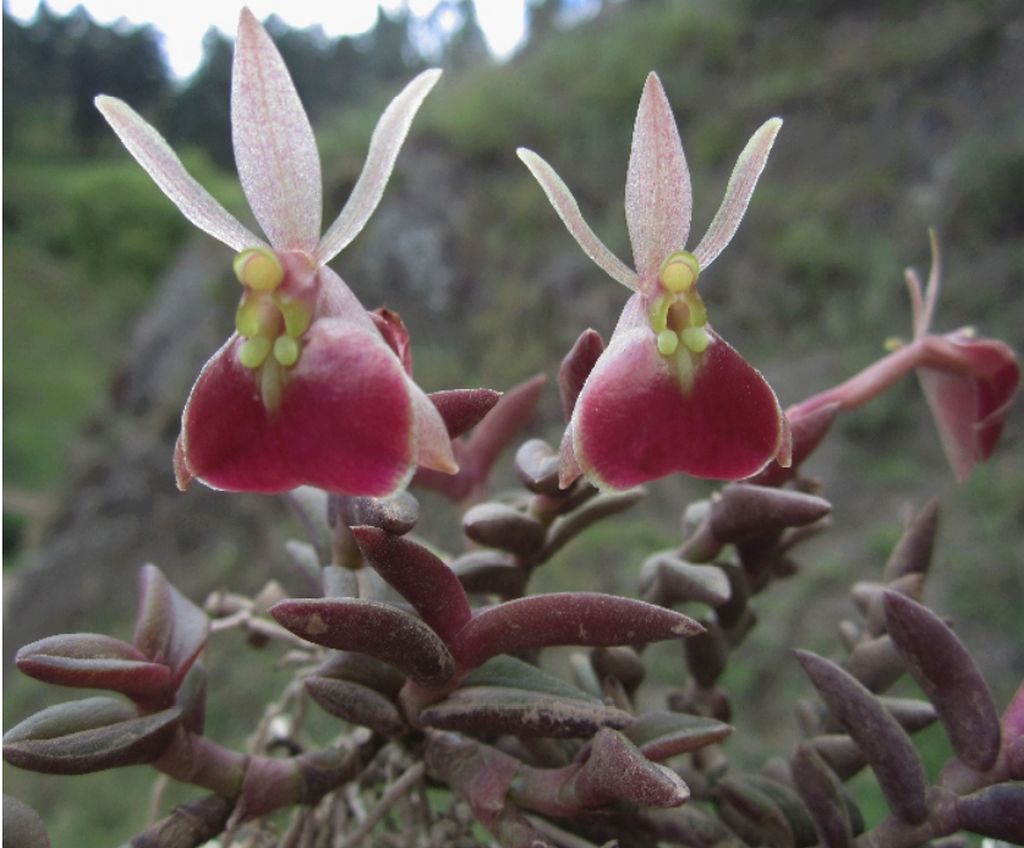

Epidendrum matthewsii Rchb.f 1876 GROUP Porpax SUBGROUP Porpax
TYPE Drawing by © Jimenez, Hágsater & E.Santiago and The AMO Herbario Website




Common Name Matthews' Epidendrum [original Collector of species 1800's]
Flower Size .8" [2 cm]
Found in southern Ecuador to northern Peru at elevations of 1600 to 3000 as a mini-miniature sized, cool to cold growing orchid with cane-like, simple, terete, erect, straight to slightly sinuous stems carrying to 6, distichous, fleshy-coriaceous, deep green above, purple-green below, linear-elliptic to linear-lanceolate, semi-terete, acute, minutely apiculate, very fleshy coriaceous, margin entire leaves that blooms in the fall on a terminal, thrugh a suborbicular, obtuse, apiculate, greenish yellow tinged with reddish purple spathe, very short, sessile, single flowered inflorescence carrying resupinate flowers without a fragrance.
"Epidendrum mathewsii belongs to the GROUP Porpax SUBGROUP Porpax, which is characterized by the sympodial, somewhat repent habit, usually forming large mats, short, cane-like stems with very fleshy, succulent, articulate, distichous leaves, single-flowered inflorescence, sessile flowers, and the lip generally reddish purple. The species is recognized by the small, compact plants with erect stems, an orbicular-subquadrate lip with the apex obtuse, and linear, acute petals. Epidendrum porpax has somewhat larger plants with somewhat reclining stems, the green flowers with a lustrous, convex, reddish purple lip proportionately wider than long, the apex rounded, sepals .34 to .56" x .16 to .2" [8.5 to 14 x 4 to 5 mm], elliptic-lanceolate. It has been often confused with Epidendrum peperomia Rchb.f. which is vegetatively similar but the lip of that species is orbicular-cordiform, spreading, as wide as it is long, with the apex obtuse; and known from Venezuela and Colombia. Epidendrum lambeauanum De Wild. has larger, prostrate, descending plants, the stems with 4 to 6 lanceolate leaves .68 to .148" [17 to 38 mm] long, the flowers are cream-colored with the lip reddish purple, and the petals linear-oblanceolate. The flowers of all these species are very similar, and best recognized by the vegetative habit. Epidendrum microporpax Hágsater has smaller leaves .4 to .64" x .14 to .2" [1.0 to 1.6 x 0.35 to 0.50 cm] on a relatively elongate erect stem, the flowers yellowish green with the center of the lip pale wine-red, sepals small .252 x .146" [6.3 x 3.6 mm], ovate, and the lip flat, with the mid-rib very short, barely surpassing the calli. Epidendrum althaniorum Hágsater & Collantes, from southern Peru (Cusco province) and neighboring Bolivia, is distinguished by the linear-triangular, acuminate petals, and the heart-shaped wine-red blotch on the lip. Epidendrum dolichoporpax Hágsater has short stems with ovate, acute flat leaves, the petals linear, acute, with the margin minutely erose, lip orbicular, cordate and the three ribs of the lip long, reaching the middle of the blade, about equal in length." Hagsater etal 2018
Synonyms Nanodes mathewsii (Rchb.f.) Rolfe 1892; Neolehmannia mathewsii (Rchb.f.) Garay 1977
References W3 Tropicos, Kew Monocot list , IPNI ; Native Ecuadorian Orchids Vol 2 Dodson 2001 photo; Icones Orchidacearum 7 Plate 739 Hagsater and Sanchez 2004 see recognition section; Icones Orchidacearum 11 Plate 1128 Hagsater & Sanchez 2008 see recognition section; Icones Orchidacearum 11 Plate 1140 Hagsater 2008 see recognition section; Icones Orchidacearum 13 Plate 1375 Hagsater & Sanchez 2010 see recognition section; Miniature Orchids, A Compendium Parsons and Gerritson 2013 photo fide; Icones Orchidacearum 14 Plate 1403 Hagsater & Santiago 2013 See recognition section; Orquideas, Tesoro de Colombia Vol 2 Ortiz & Uribe 2017 photo fide; Icones Orchidacearum 16[1] Plate 1615 Hagsater & Santiago 2018 See Recognition section; Icones Orchidacearum 16[1] Plate 1633 Hagsater & Santiago 2018 See recognition section; Icones Orchidacearum 16[1] Plate 1640 Hagsater & Sanchez 2018 drawing/photo fide; Icones Orchidacearum 16[1] Plate 1643 Hagsater & Sanchez 2018 see recognition section; Icones Orchidacearum 17(2) Plate 1771 Hagsater & Jimenez 2020 see recognition section
----------------------------------------------------------------------------------------------------------